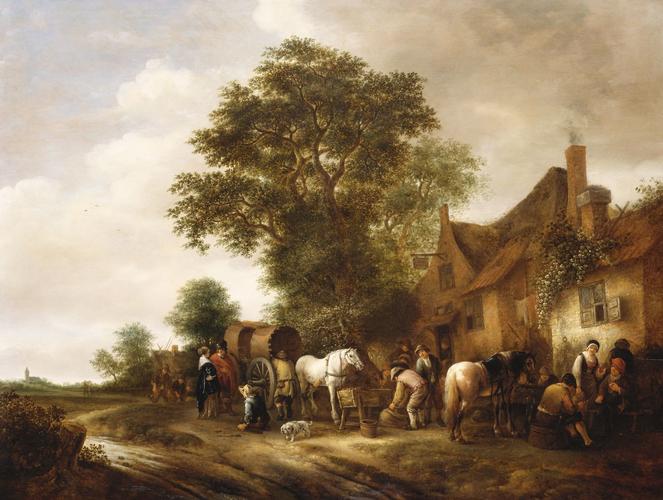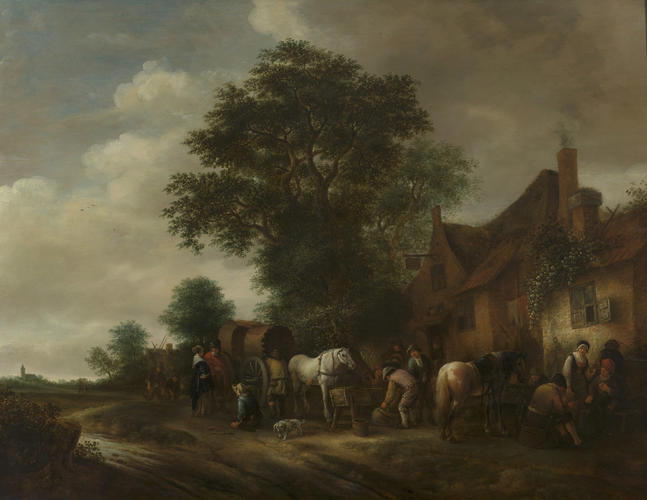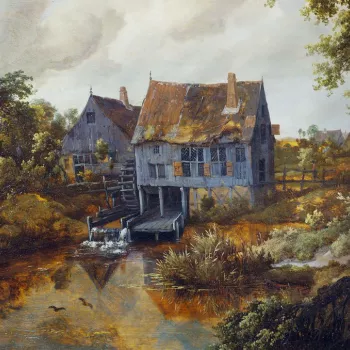Travellers outside an Inn Signed and dated 1647
Oil on panel | 83.2 x 109.5 cm (support, canvas/panel/stretcher external) | RCIN 405216
-
Isaac van Ostade (1621-49) was a pupil of his much older brother, Adriaen van Ostade, and painted in Haarlem for a decade before his early death. His work, like that of his brother, represents a cheerful domestication of the satirical depiction of peasant life seen in Pieter Bruegel the Elder and Adriaen Brouwer. The way in which the landscape is composed and executed in this work demonstrates the influence of the so-called ‘tonal school’, a group of artists who passed through Haarlem in the 1610s and 1620s, creating a style which conveys with minimal means a dank, atmospheric distillation of a river or roadside scene. Ostade’s diagonal composition, his muted colour range, thin application of paint and organic confusion of buildings, trees, grass and earth, as if every part of the scene were marinated in mud, perfectly exhibits the effects of the tonal school.
The meaning of this scene is appropriately conveyed by these frugal means. The cart with the open sides is adapted for the transport of the rich, but is not as fashionable as a coach. The bourgeois couple (the only ones wearing bright colours or distinct blacks and whites) have taken a byroad where they stop at a down-at-heel inn, staffed by harmless drudges whose forms are submerged in the sludgy light and whose round backs resemble those of beasts of burden. A beggar shuffles on wooden blocks and hand-held pattens; beggars of all descriptions are surprisingly common within Dutch landscape.
The qualities of this painting go a long way to explaining its modest value in the eyes of George IV’s cataloguer (it was valued at 100 guineas in 1819); it is nonetheless surprising that similar works by David Teniers the Younger were so highly prized. At this same time David Wilkie was creating a distinctive style of genre painting out of a fusion of the Flemish and Dutch traditions and seems to have worked out how to create Dutch effects and charge Flemish prices: his Village Holiday (Tate, London) was painted for John Julius Angerstein in 1811 at a cost of 800 guineas. The earth colours and soft dappled half-light are especially reminiscent of Isaac van Ostade’s work, as is the stuffed-toy rusticity of the figures. George IV acquired his first Wilkie – Blind Man’s Buff (Royal Collection, RCIN 405537) – in 1812 for 500 guineas.
Signed and dated, lower left: 'Isack van Ostade / 1647'Provenance
Purchased by George IV from Sir Thomas Baring as part of a group of 86 Dutch and Flemish paintings, most of which were collected by Sir Thomas’s father, Sir Francis Baring; they arrived at Carlton House on 6 May 1814; Jan Gildemeester was a previous owner; recorded in the Upper Anti Room at Carlton House in 1819 (no 152); in the Picture Gallery at Buckingham Palace in 1841 (no 72)
-
Medium and techniques
Oil on panel
Measurements
83.2 x 109.5 cm (support, canvas/panel/stretcher external)
110.7 x 136.1 x 5.5 cm (frame, external)
Other number(s)
Alternative title(s)
A road scene, previously entitled










